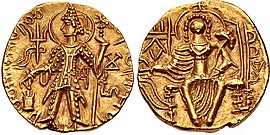Territories/
dates |
Western India |
Western Pakistan
Balochistan |
Paropamisadae
Arachosia
|
Bajaur |
Gandhara |
Western Punjab |
Eastern Punjab |
Mathura |
Pataliputra
|
|
|
|
INDO-SCYTHIAN KINGDOM
|
INDO-GREEK KINGDOM
|
INDO-SCYTHIAN Northern Satraps
|
|
| 25 BCE – 10 CE
|
|
|
Indo-Scythian dynasty of the
APRACHARAJAS
Vijayamitra
(ruled 12 BCE – 15 CE)
|
Liaka Kusulaka
Patika Kusulaka
Zeionises
|
Kharahostes
(ruled 10 BCE– 10 CE)
Mujatria
|
Strato II and Strato III
|
Hagana
|
|
| 10-20CE
|
|
INDO-PARTHIAN KINGDOM
Gondophares
|
Indravasu
|
INDO-PARTHIAN KINGDOM
Gondophares
|
Rajuvula
|
| 20–30 CE
|
|
Ubouzanes
Pakores
|
Vispavarma
(ruled c. 0–20 CE)
|
Sarpedones
|
Bhadayasa
|
Sodasa
|
| 30-40 CE
|
|
KUSHAN EMPIRE
Kujula Kadphises (c. 50–90)
|
Indravarma
|
Abdagases
|
...
|
...
|
| 40–45 CE
|
|
|
Aspavarma
|
Gadana
|
...
|
...
|
| 45–50 CE
|
|
|
Sasan
|
Sases
|
...
|
...
|
| 50–75 CE
|
|
|
...
|
...
|
| 75–100 CE
|
Indo-Scythian dynasty of the
WESTERN SATRAPS
Chastana
|
|
Vima Takto (c. 90–113)
|
...
|
...
|
| 100–120 CE
|
Abhiraka
|
|
Vima Kadphises (c. 113–127)
|
| 120 CE
|
Bhumaka
Nahapana
|
PARATARAJAS
Yolamira
|
Kanishka I (c. 127–151)
|
Great Satrap Kharapallana
and Satrap Vanaspara
for Kanishka I
|
|
| 130–230 CE
|
Jayadaman
Rudradaman I
Damajadasri I
Jivadaman
Rudrasimha I
Isvaradatta
Rudrasimha I
Jivadaman
Rudrasena I
|
Bagamira
Arjuna
Hvaramira
Mirahvara
|
Huvishka (c. 151 – c. 190)
Vasudeva I (c. 190 – 230)
|
| 230–250 CE
|
Samghadaman
Damasena
Damajadasri II
Viradaman
Yasodaman I
Vijayasena
Damajadasri III
Rudrasena II
Visvasimha
|
Miratakhma
Kozana
Bhimarjuna
Koziya
Datarvharna
Datarvharna
|
KUSHANO-SASANIANS
Ardashir I (c. 230 – 250)
Ardashir II (?-245)
|
Kanishka II (c. 230 – 247)
|
|
| 250–280
|
Peroz I, "Kushanshah" (c. 250 – 265)
Hormizd I, "Kushanshah" (c. 265 – 295)
|
Vāsishka (c. 247 – 267)
Kanishka III (c. 267 – 270)
|
| 280–300
|
Bhratadarman
|
Datayola II
|
Hormizd II, "Kushanshah" (c. 295 – 300)
|
Vasudeva II (c. 267 – 300)
|
GUPTA EMPIRE
Chandragupta I
Samudragupta
Chandragupta II
|
| 300–320 CE
|
Visvasena
Rudrasimha II
Jivadaman
|
|
Peroz II, "Kushanshah" (c. 300 – 325)
|
Mahi (c. 300–305)
Shaka (c. 305 – 335)
|
| 320–388 CE
|
Yasodaman II
Rudradaman II
Rudrasena III
Simhasena
Rudrasena IV
|
|
Varahran I (325–350)
Shapur II Sassanid king and "Kushanshah" (c. 350)
|
Kipunada (c. 335 – 350)
|
| 388–396 CE
|
Rudrasimha III
|
|
KIDARITES invasion
|
- From the dated inscription on the Rukhana reliquary
- Richard Salomon (July–September 1996). "An Inscribed Silver Buddhist Reliquary of the Time of King Kharaosta and Prince Indravarman". Journal of the American Oriental Society. 116 (3): 418–452 . JSTOR 605147.
- Richard Salomon (1995) . "A Kharosthī Reliquary Inscription of the Time of the Apraca Prince Visnuvarma". South Asian Studies. 11 (1): 27–32. doi:10.1080/02666030.1995.9628492.
- ^ Jongeward, David; Cribb, Joe (2014). Kushan, Kushano-Sasanian, and Kidarite Coins A Catalogue of Coins From the American Numismatic Society by David Jongeward and Joe Cribb with Peter Donovan. p. 4.
|
 Coinage of Mahi, c. 300–305 CE.
Coinage of Mahi, c. 300–305 CE.![]() Ma-hi) was a Kushan ruler, whose reign is dated to circa 300–305 CE. He probably succeeded Vasudeva II, and his successor was Shaka. Mahi was among the last Kushan Emperors, before they were overrun by the Kidarites.
Ma-hi) was a Kushan ruler, whose reign is dated to circa 300–305 CE. He probably succeeded Vasudeva II, and his successor was Shaka. Mahi was among the last Kushan Emperors, before they were overrun by the Kidarites.

